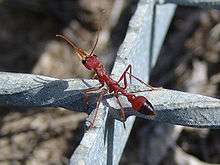Myrmeciinae
Myrmeciinae is a subfamily of the Formicidae, ants once found worldwide but now restricted to Australia and New Caledonia. This subfamily is one of several ant subfamilies which possess gamergates, female worker ants which are able to mate and reproduce, thus sustaining the colony after the loss of the queen.[2] The Myrmeciinae subfamily was formerly composed of only one genus, Myrmecia, but the subfamily was redescribed by Ward & Brady in 2003 to include two tribes and four genera:[3] An additional three genera, one form genus, and 9 species were described in 2006 from the Early Eocene of Denmark, Canada, and Washington.[4]
| Myrmeciinae | |
|---|---|
 | |
| Myrmecia gulosa | |
| Scientific classification | |
| Kingdom: | Animalia |
| Phylum: | Arthropoda |
| Class: | Insecta |
| Order: | Hymenoptera |
| Family: | Formicidae |
| Subfamily: | Myrmeciinae Emery, 1877 |
| Type genus | |
| Myrmecia | |
| Tribes and genera | |
|
2 extant genera; 5 fossil genera; 2 tribes[1] | |
Tribes and genera
- Tribe Myrmeciini Emery, 1877
- Myrmecia Fabricius, 1804
- Tribe Prionomyrmecini Wheeler, 1915
- Nothomyrmecia Clark, 1934
- †Prionomyrmex Mayr, 1868
- Tribe incertae sedis
- †Archimyrmex Cockerell, 1923
- †Avitomyrmex Archibald, Cover & Moreau, 2006
- †Macabeemyrma Archibald, Cover & Moreau, 2006
- †Ypresiomyrma Archibald, Cover & Moreau, 2006
- Form genus (for species belonging to the subfamily but not identifiable to current genera)
- †Myrmeciites Archibald, Cover & Moreau, 2006
Classification
The subfamily Myrmeciinae was established by Italian entomologist Carlo Emery in 1877 under the original name Myrmeciidae.[5] It was named after the genus Myrmecia, the type genus of the subfamily.[6] In 1882, the subfamily was treated as a tribe by French entomologist Ernest André within the former ant family Myrmicidae, but it would later be moved to the family Poneridae in 1905.[7][8]
See also
References
- Bolton, B. (2013), "An online catalog of the ants of the world.", AntCat, retrieved 22 September 2013
- Dietemann, Vincent; Peeters, Christian; Hölldobler, Bert (2004). "Gamergates in the Australian ant subfamily Myrmeciinae". Naturwissenschaften. 91 (9): 432–435. Bibcode:2004NW.....91..432D. doi:10.1007/s00114-004-0549-1. PMID 15278223.
- Ward, Philip S.; Brady, Seán G. (2003). "Phylogeny and biogeography of the ant subfamily Myrmeciinae (Hymenoptera : Formicidae)" (PDF). Invertebrate Systematics. 17 (3): 361–386. doi:10.1071/IS02046.
- Archibald, S.B.; Cover, S. P.; Moreau, C. S. (2006). "Bulldog Ants of the Eocene Okanagan Highlands and History of the Subfamily (Hymenoptera: Formicidae: Myrmeciinae)" (PDF). Annals of the Entomological Society of America. 99 (3): 487–523. doi:10.1603/0013-8746(2006)99[487:BAOTEO]2.0.CO;2.
- Emery, Carlo (1877). "Saggio di un ordinamento naturale dei Mirmicidei e considerazioni sulla filogenesi delle formiche" (PDF). Bullettino della Società Entomologica Italiana. 9: 67–83. doi:10.5281/zenodo.25408.
- Reiskind, Jonathan (1983). "Request for a ruling to correct homonymy in names of the family-groups based on Myrmecia (Insecta) and Myrmecium (Arachnida)". Bulletin of Zoological Nomenclature. 40: 43–44.
- André, Ernest (1882). "Les fourmis (continuation)" (PDF). Species des Hyménoptères d'Europe et d'Algérie. 2: 233–280. doi:10.5281/zenodo.27099.
- Ashmead, William H. (1905). "A skeleton of a new arrangement of the families, subfamilies, tribes and genera of the ants, or the superfamily Formicoidea" (PDF). The Canadian Entomologist. 37 (11): 381–384. doi:10.4039/Ent37381-11.
External links

